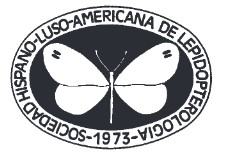Relación entre las características de la vegetación y la diversidad de Lepidoptera en el bosque Hircaniano, Irán (Insecta: Lepidoptera)
DOI:
https://doi.org/10.57065/shilap.73Palabras clave:
Insecta, Lepidoptera, conservación, riqueza, bosque templado, vegetación, IránResumen
Los patrones de diversidad de los Lepidoptera y su relación con las características ambientales en los bosques Hircanianos del norte de Irán no se han investigado hasta ahora, mientras que estos estudios son sumamente eficaces para restaurar la biodiversidad forestal. Este estudio tenía como objetivo evaluar las relaciones entre las características de la vegetación y la abundancia y diversidad de Lepidoptera en el bosque Darabkola, distrito de Sari (provincia de Mazandaran, norte de Irán). Mediante trampas de luz se obtuvieron un total de 474 ejemplares que representaban 84 especies y pertenecían a 16 familias. Se registraron 31 especies de plantas pertenecientes a 28 géneros y 23 familias de tres bosques distintos de la región. El número total de especies de plantas y el α de Fisher mostraron la diferencia significativa. El análisis de regresión indicó que la abundancia de Lepidoptera estaba correlacionada con el área basal, el diámetro a la altura del pecho y la densidad de los árboles, aunque no se observó una relación significativa entre las características de las plantas y el α de Fisher de los Lepidoptera. La falta de una relación significativa entre la diversidad de plantas y la abundancia y diversidad de Lepidoptera representa el débil papel de la diversidad de plantas en la creación de patrones de diversidad en los ecosistemas forestales.
Descargas
Estadísticas globales ℹ️
|
394
Visualizaciones
|
296
Descargas
|
|
690
Total
|
|
Citas
AARVIK, L., BENGTSSON, B. Å., ELVEN, H., IVINSKIS, P., JÜRIVETE, U., KARSHOL, O., MUTANEN, M. & SAVENKOV, N., 2017.– Nordic-Baltic Checklist of Lepidoptera.– Norwegian Journal of Entomology, 3: 1-237.
AXMACHER, J. C., TÜNTE, H., SCHRUMPF, M., MÜLLER-HOHENSTEIN, K., LYARUU, H. V. M. & FIEDLER, K., 2004.– Diverging diversity patterns of vascular plants and geometrid moths during forest regeneration on Mt Kilimanjaro, Tanzania.– Journal of Biogeography, 31: 895-904. DOI: https://doi.org/10.1111/j.1365-2699.2004.00995.x
AXMACHER, J. C., BREHM, G., HEMP, A., TÜNTE, H., LYARUU, H. V., MÜLLER-HOHENSTEIN, K. & FIEDLER, K., 2009.– Determinants of diversity in Afrotropical herbivorous insects (Lepidoptera: Geometridae): plant diversity, vegetation structure or abiotic factors?- Journal of Biogeography, 36(2): 337-349. DOI: https://doi.org/10.1111/j.1365-2699.2008.01997.x
AXMACHER, J. C., LIU, Y., WANG, C., LI, L. & YU, Z., 2011.– Spatial α-diversity patterns of diverse insect taxa in Northern China: Lessons for biodiversity conservation.– Biological Conservation, 144: 2362-2368. DOI: https://doi.org/10.1016/j.biocon.2011.06.016
BORER, E. T., SEABLOOM, E. W. & TILMAN, D., 2012.– Plant diversity controls arthropod biomass and temporal stability.– Ecology letters, 15: 1457-64. DOI: https://doi.org/10.1111/ele.12006
BREHM, G., HOMEIER, J. & FIEDLER, K., 2003.– Beta diversity of geometrid moths (Lepidoptera: Geometridae) in an Andean montane rainforest.– Diversity and Distributions, 9: 351-366. DOI: https://doi.org/10.1046/j.1472-4642.2003.00023.x
CHOI, S. W., 2011.– Moth diversity and identification of indicator species in temperate forests of southern South Korea.– Annals of the Entomological Society of America, 104: 952-959. DOI: https://doi.org/10.1603/AN10130
COOK-PATTON, S., MCART, S. H., PARACHNOWITSCH, A. L., THALER, J. S. & AGRAWAL, A. A., 2011.– A direct comparison of the consequences of plant genotypic and species diversity on communities and ecosystem function.– Ecology, 92: 915-923. DOI: https://doi.org/10.1890/10-0999.1
CUEVAS-REYES, P., SIEBE, C., MARTÍNEZ-RAMOS, M. & OYAMA, K., 2003.– Species richness of gallforming insects in a tropical rain forest: correlations with plant diversity and soil fertility.– Biodiversity and Conservation, 12: 411-422. DOI: https://doi.org/10.1023/A:1022415907109
DELABYE, S., MAICHER, V., SÁFIÁN, S., DOLEZAL, J., ALTMAN, J., JANEGEK, S., KOBE, I. N., MURKWE, M., SEBEK, P. & TROPEK, R., 2021.– Butterfly and moth communities differ in their response to habitat structure in rainforests of Mount Cameroon.– Biotropica, 53(2): 567-580. DOI: https://doi.org/10.1111/btp.12900
EBELING, A., HINES, J., HERTZOG, L. R., LANGE, M., MEYER, S. T., SIMONS, N. K. & WEISSER, W. W., 2018.– Plant diversity effects on arthropods and arthropod-dependent ecosystem functions in a biodiversity experiment.– Basic and Applied Ecology, 26: 50-63. DOI: https://doi.org/10.1016/j.baae.2017.09.014
FERRO, V. G. & ROMANOWSKI, H. P., 2012.– Diversity and composition of tiger moths (Lepidoptera: Arctiidae) in an area of Atlantic Forest in southern Brazil: is the fauna more diverse in the grassland or in the forest.– Revista Brasileira de Zoologia, 29: 7-18. DOI: https://doi.org/10.1590/S1984-46702012000100002
HAWKINS, B. A. & PORTER, E. E., 2003.– Does herbivore diversity depend on plant diversity? The case of California butterflies.– American naturalist, 161: 40-49. DOI: https://doi.org/10.1086/345479
HOOPER, D. U., CHAPIN III, F. S., EWEL, J. J., HECTOR, A., INCHAUSTI, P., LAVOREL, S., LAWTON, J. H., LODGE, D. M., LOREAU, M., NAEEM, S. & SCHMID, B., 2005.– Effects of biodiversity on ecosystem functioning: a consensus of current knowledge.– Ecological monographs, 75(1): 3-35. DOI: https://doi.org/10.1890/04-0922
HORVATH, B., TOTH, V. & LAKATOS, F., 2016.– Relation between canopy-layer traits and moth communities in sessile oak-hornbeam forests.– North-Western Journal of Zoology, 12: 213-219.
KRISTENSEN, N. P., SCOBLE, M. J. & KARSHOLT, O., 2007.– Lepidoptera phylogeny and systematics: the state of inventorying moth and butterfly diversity.– Zootaxa, 1668: 699-747. DOI: https://doi.org/10.11646/zootaxa.1668.1.30
MAGURA, T., TÓTHMÉRÉSZ, B. & ELEK, Z., 2005.– Impacts of leaf-litter addition on carabids in a conifer plantation.– Biodiversity and Conservation, 14: 475-91. DOI: https://doi.org/10.1007/s10531-004-7307-8
MERCKX, T., FEBER, R. E., RIORDAN, P., TOWNSEND, M. C., BOURN, N. A., PARSONS, M. S. & MACDONALD, D. W., 2009.– Optimizing the biodiversity gain from agri-environment schemes.– Agriculture, Ecosystems & Environment, 130(3-4): 177-182. DOI: https://doi.org/10.1016/j.agee.2009.01.006
MERCKX, T., DE MIRANDA, M. D. & PEREIRA, H. M., 2019.– Habitat amount, not patch size and isolation, drives species richness of macro-moth communities in countryside landscapes.– Journal of Biogeography, 46: 56-967. DOI: https://doi.org/10.1111/jbi.13544
MÜLLER, J., VARANDI, H. B., BABAII, M. R., FARASHIANI, M. E., SAGEB-TALEBI, K., LANGE, F., GOSSNER, M. M., JARZABEK-MÜLLER, A., ROTH, N., THORN, S. & SEIBOLD, S., 2018.– The diversity of saproxylic insects (Coleoptera, Heteroptera) on four tree species of the Hyrcanian forest in Iran.– Journal of Insect Conservation, 22(3): 607-625. DOI: https://doi.org/10.1007/s10841-018-0089-1
NYAFWONO, M., VALTONEN, A., NYEKO, P., OWINY, A. A. & ROININEN, H., 2015.– Tree community composition and vegetation structure predict butterfly community recovery in a restored Afrotropical rain forest.– Biodiversity and Conservation, 24: 1473-1485. DOI: https://doi.org/10.1007/s10531-015-0870-3
OXBROUGH, A., FRENCH, V., IRWIN, S., KELLY, T. C., SMIDDY, P. & O’HALLORAN, J., 2012.– Can mixed species stands enhance arthropod diversity in plantation forests?- Forest Ecology Management, 270: 11-18. DOI: https://doi.org/10.1016/j.foreco.2012.01.006
ÖZDEMIR, M., 2019.– Habitat preference of Geometridae species in western black sea region of Turkey (Lepidoptera: Geometridae).– SHILAP Revista de lepidopterología, 47: 673-684. DOI: https://doi.org/10.57065/shilap.496
PEARSON, C. V. & DYER, L. A., 2006.– Trophic diversity in two grassland ecosystems.– Journal of Insect Science, 6: 1-11. DOI: https://doi.org/10.1673/2006_06_25.1
RABIEH, M. M., 2018.– Biodiversity of noctuid moths (Lepidoptera: Noctuidae) in the agroecosystems of Mashhad County.– Biodiversity International Journal, 2: 147-151. DOI: https://doi.org/10.15406/bij.2018.02.00057
RABL, D., GOTTSBERGER, B., BREHM, G., HOFHANSL, F. & FIEDLER, K., 2020.– Moth assemblages in Costa Rica rain forest mirror small-scale topographic heterogeneity.– Biotropica, 52: 288-301. DOI: https://doi.org/10.1111/btp.12677
ROOT, H. T., VERSCHUYL, J., STOKELY, T., HAMMOND, P., SCHERR, M. A. & BETTS, M. G., 2017.– Plant diversity enhances moth diversity in an intensive forest management experiment.– Ecological Applications, 27: 134-142. DOI: https://doi.org/10.1002/eap.1426
SAGHEB-TALEBI, K., SAJEDI, T. & POURHASHEMI, M., 2014.– Plant and vegetation: Forests of Iran-a treasure from the past, a hope for the future: VIII + 152 pp. Springer. Dordrecht. DOI: https://doi.org/10.1007/978-94-007-7371-4
SCHERBER, C., EISENHAUER, N., WEISSER, W. W., SCHMID, B., VOIGT, W., FISCHER, M., SCHULZE, E.- D., ROSCHER, CH., WEIGELT, A., ALLAN, E., BEßLER, H., BONKOWSKI, M., BUCHMANN, N., BUSCOT, F., CLEMENT, L. W., EBELING, A., ENGELS, CH., HALLE, S., KERTSCHER, I., KLEIN, A.-
M., KOLLER, R., KÖNIG, S., KOWALSKI, E., KUMMER, V., KUU, A., LANGE, M., LAUTERBACH, D., MIDDELHOFF, C., MIGUNOVA, V. D., MILCU, A., MÜLLER, R., PARTSCH, S., PETERMANN, J. S., RENKER, C., ROTTSTOCK, T., SABAIS, A., SCHEU, S., SCHUMACHER, J., TEMPERTON, V. M. &
TSCHARNTKE, T., 2010.– Bottom-up effects of plant diversity on multitrophic interactions in a biodiversity experiment.– Nature, 468: 553-556.
SILANDER, J. A., 2001.– Temperate forests.– Encyclopedia of Biodiversity, 5: 607-625. DOI: https://doi.org/10.1016/B0-12-226865-2/00267-4
TYLER, T., 2020.– Relationship between moth (night active Lepidoptera) diversity and vegetation characteristics in southern Sweden.– Journal of Insect Conservation, 24: 1005-1015. DOI: https://doi.org/10.1007/s10841-020-00270-y
UHL, B., WÖLFING, M., FIALA, B. & FIEDLER, K., 2016.– Micro-moth communities mirror environmental stress gradients within a Mediterranean nature reserve.– Basic and Applied Ecology, 17: 273-281. DOI: https://doi.org/10.1016/j.baae.2015.10.002
UNSICKER, S. B., BAER, N., KAHMEN, A., WAGNER, M., BUCHMANN, N. & WEISSER, W. W., 2006.– Invertebrate herbivory along a gradient of plant species diversity in extensively managed grasslands.– Oecologia, 150: 233-246. DOI: https://doi.org/10.1007/s00442-006-0511-3
ZOU, Y., SANG, W., ZHOU, H., HUANG, L. & AXMACHER, J. C., 2014.– Altitudinal diversity patterns of ground beetles (Coleoptera: Carabidae) in the forests of Changbai Mountain, Northeast China.– Insect Conservation and Diversity, 7: 161-171. DOI: https://doi.org/10.1111/icad.12039
ZOU, Y., SANG, W. G., WARREN-THOMAS, E. & AXMACHER, J. C., 2016.– Geometrid moth assemblages reflect high conservation value of naturally regenerated secondary forests in temperate China.– Forest Ecology and Management, 374: 111-118. DOI: https://doi.org/10.1016/j.foreco.2016.04.054
Publicado
Cómo citar
Número
Sección
Licencia
Derechos de autor 2022 G. Hajizadeh, H. Jalilvand, M. R. Kavosi, H. B. Varandi

Esta obra está bajo una licencia internacional Creative Commons Atribución 4.0.
El autor retiene sus derechos de marca y patente sobre cualquier proceso o procedimiento dentro del artículo.
El autor retiene el derecho de compartir, distribuir, ejecutar y comunicar públicamente el artículo publicado en SHILAP Revista de lepidopterología, con reconocimiento inicial de su publicación en SHILAP Revista de lepidopterología.
El autor retiene el derecho para hacer una posterior publicación de su trabajo, de utilizar el artículo a publicarlo en un libro, siempre que indique su publicación inicial en SHILAP Revista de lepidopterología.
Cada envío a SHILAP Revista de lepidopterología debe ir acompañado de una aceptación de los derechos de autor y del reconocimiento de autoría. Al aceptarlos, los autores conservan los derechos de autor de su trabajo y aceptan que el artículo, si es aceptado para su publicación por SHILAP Revista de lepidopterología, tendrá una licencia de uso y distribución “Reconocimiento 4.0 Internacional de Creative Commons” (CC BY 4.0), que permite a terceros compartir y adaptar el contenido para cualquier propósito dando el crédito apropiado al trabajo original.
Puede consultar desde aquí la versión informativa y el texto legal de la licencia. La indicación de la licencia CC BY 4.0 debe indicarse expresamente de esta manera cuando sea necesario.
A partir de 2022, el contenido de la versión impresa y digital se encuentra bajo una licencia de uso y distribución “Reconocimiento 4.0 Internacional de Creative Commons” (CC BY 4.0), que permite a terceros compartir y adaptar el contenido para cualquier propósito dando el crédito apropiado al trabajo original.
El contenido anterior de la revista se publicó bajo una licencia tradicional de derechos de autor; sin embargo, el archivo está disponible para acceso gratuito.
Al usar el contenido de SHILAP Revista de lepidopterología publicado antes del año 2022, incluidas figuras, tablas o cualquier otro material en formato impreso o electrónico pertenecen a los autores de los artículos, los autores deben obtener el permiso del titular de los derechos de autor. Las responsabilidades legales, financieras y penales a este respecto pertenecen al autor(es).
En aplicación del Principio de Prioridad del Código Internacional de Nomenclatura Zoologica, no se autoriza el depósito en repositorios, páginas web personales o similares de cualquier otra versión distinta a la publicada por el editor.




























